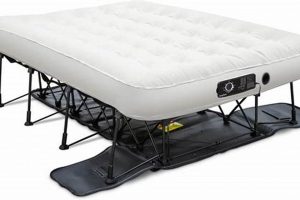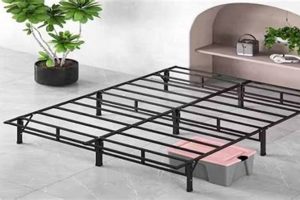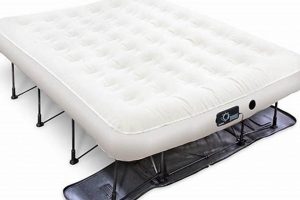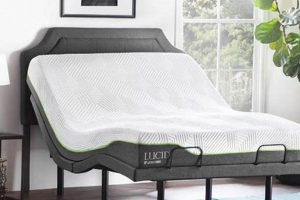A queen-size bed frame typically measures around 60 inches in width. This dimension is crucial for accommodating a standard queen mattress, ensuring proper support and preventing overhang. Variations can occur based on the frame’s style, such as platform, sleigh, or traditional frames, which may add a few inches to the overall width.
The width of a bed frame is an essential consideration for bedroom space planning. Selecting a frame that accurately fits the mattress dimensions prevents structural instability and enhances the bed’s longevity. Inadequate frame support can lead to premature mattress wear and compromise sleep quality. Historically, standardized bed sizes have evolved to optimize comfort and space utilization within residential dwellings.
Understanding the typical width allows for informed decisions when selecting bedding, bedroom furniture, and designing room layouts. Further considerations include the frame’s material, height, and headboard/footboard design, all contributing to the overall aesthetic and functionality of the sleeping area. The subsequent sections will delve into specific frame types and their dimensional nuances.
Considerations for Queen Bed Frame Width
Accurate assessment of available space is paramount when selecting a bed frame. The width of the frame is a crucial factor in ensuring the bed fits comfortably within the room without obstructing movement or other furniture placement.
Tip 1: Measure the Room: Before purchasing a bed frame, meticulously measure the bedroom’s dimensions. Account for doorways, windows, and other permanent fixtures to determine the maximum allowable width for the bed and surrounding furniture.
Tip 2: Account for Extra Width: Standard queen mattresses are approximately 60 inches wide. However, bed frames may add several inches to this dimension. Platform frames, in particular, often extend beyond the mattress edge. Always check the frame’s specifications.
Tip 3: Consider Headboard and Footboard Styles: Headboards and footboards can significantly increase the overall width. Ornate or oversized designs may require additional clearance. Factor these design elements into the spatial calculations.
Tip 4: Allow for Side Tables: Bedside tables are commonly placed alongside the bed. Ensure sufficient space remains after accounting for the bed frame’s width to accommodate these essential pieces of furniture comfortably.
Tip 5: Plan for Walkways: Leave adequate space for walkways around the bed. A minimum of 24 inches is recommended to allow for easy movement. Constricted walkways can make the room feel cramped and hinder accessibility.
Tip 6: Think About Future Needs: Consider potential future furniture additions. Select a bed frame width that allows for flexibility in room arrangement should needs evolve.
Proper planning and attention to dimensional details ensures a harmonious and functional bedroom layout. Accurate assessment of the frame’s size relative to the room’s dimensions is crucial for optimal space utilization and comfort.
The following sections will explore specific frame styles and their implications for room design.
1. Standard width
The standard width of a queen mattress frame serves as a fundamental consideration in bedroom design and furniture selection. It directly dictates the space required to accommodate the bed, influencing the arrangement of other furnishings and the overall flow of the room.
- Mattress Compatibility
The primary function of the standard width is to provide a secure and appropriate fit for a standard queen-size mattress. This compatibility prevents excessive mattress movement and ensures even weight distribution, contributing to sleep comfort and extending mattress lifespan. A frame significantly wider than the mattress may create gaps and instability, while a frame too narrow will not properly support the mattress.
- Room Planning Considerations
The standard width, typically around 60 inches, is a critical dimension for spatial planning. Knowing this measurement allows for accurate calculation of available space and facilitates the selection of complementary bedroom furniture, such as nightstands and dressers. Overlooking this dimension can lead to a cramped and dysfunctional room layout.
- Frame Style Adaptations
While the internal dimension aims to be consistent, external frame styles can modify the overall width. Platform beds, for instance, often extend beyond the mattress edge for aesthetic or functional reasons. Bed frames with elaborate headboards or footboards also increase the total width. Awareness of these variations ensures accurate space allocation.
- Accessibility and Movement
The selected frame width impacts the ease of movement around the bed. Sufficient clearance should be maintained on all sides to allow for comfortable access and prevent obstructions. A wider frame necessitates more open space, particularly in smaller bedrooms, to avoid a crowded feeling.
In summary, the standard width forms the base for determining the required footprint of the sleeping area. While variations exist due to frame style, understanding this dimension allows for optimized space utilization, harmonious furniture arrangement, and enhanced accessibility within the bedroom environment. Therefore, assessing the standard width is important in understanding how wide a queen mattress frame should be in the bedroom.
2. Frame style
The style of a queen mattress frame directly influences its overall width. While the interior dimensions must accommodate a standard 60-inch queen mattress, the exterior dimensions can vary significantly based on design choices. For example, a minimalist metal frame might add only an inch or two to the mattress’s width, whereas a traditional sleigh bed frame, with its curved headboard and footboard, could increase the total width by a foot or more.
Different frame styles serve distinct functional and aesthetic purposes, impacting bedroom space requirements. Platform beds, often chosen for their modern appeal, typically extend beyond the mattress edge to create a visual “platform,” thereby increasing the frame’s width. Upholstered frames, while providing a softer aesthetic, can add considerable width due to the padding and fabric wrapping. The chosen style can either maximize or minimize the perceived space within a room, depending on its proportions and design elements.
Therefore, when assessing the width, considering the interplay between structural necessity and aesthetic preference is crucial. The practical significance of understanding this lies in the ability to accurately plan bedroom layouts, select appropriate bedding, and ensure that the chosen frame not only supports the mattress effectively but also harmonizes with the overall room design. Failure to consider the style’s impact on width can result in spatial inefficiencies and aesthetic imbalances.
3. Headboard addition
The addition of a headboard to a queen mattress frame directly impacts its overall width. A standard queen mattress measures 60 inches wide; however, the headboard, attached at the head of the frame, invariably extends this measurement. The extent of the increase depends on the design and dimensions of the headboard itself. For instance, a minimalist headboard might add only an inch or two to either side of the frame, whereas a more elaborate or wingback-style headboard could increase the total width by several inches. This variance necessitates precise measurement of both the mattress frame and the headboard prior to final placement within a bedroom to ensure adequate space and avoid obstruction. The cause is the physical addition of the headboard to the frame. The effect is a change in the width of the entire bed structure.
The importance of accounting for headboard dimensions extends beyond mere spatial considerations. The headboard’s width affects the placement of bedside tables and other accompanying furniture. It can also influence the visual balance of the room. A headboard that is disproportionately wide relative to the room’s size might overwhelm the space, while a narrower headboard could appear insignificant. Real-life examples include bedrooms where poorly planned headboard additions have resulted in cramped walkways or obstructed access to electrical outlets. Careful planning during the selection process mitigates these challenges.
In summary, the addition of a headboard is a significant factor in determining the overall width of a queen mattress frame. Understanding its influence allows for informed decisions regarding space planning, furniture placement, and the overall aesthetic balance of the bedroom. While the mattress width remains constant, the headboard introduces a variable that demands careful consideration to ensure both functional and visual harmony. A failure to account for this variable leads to challenges in room design.
4. Footboard influence
The footboard exerts a direct influence on the overall width of a queen mattress frame. While a standard queen mattress maintains a width of approximately 60 inches, the addition of a footboard extends this dimension. The degree of extension varies depending on the footboard’s design, ranging from minimalist low-profile additions that contribute only a few inches to more substantial, ornate designs that can significantly increase the total width. For example, a sleigh bed footboard, with its curved and often outward-extending form, demonstrably widens the frame’s footprint compared to a simple, straight footboard. The primary cause of this increased width is the physical addition of the footboard structure to the end of the frame, thereby expanding the overall horizontal span. This necessitates accurate measurements to ensure the bed fits appropriately within the intended bedroom space.
The practical significance of understanding the footboard’s influence lies in its impact on bedroom layout and functionality. A wider frame, resulting from a substantial footboard, requires more floor space and may restrict movement within the room. Careful consideration of the footboard’s dimensions is crucial when planning the placement of other furniture, such as dressers and nightstands. Real-world examples include bedrooms where an oversized footboard impedes access to closets or obstructs pathways, highlighting the need for precise measurements and mindful space allocation during the design phase. Failing to account for the footboard’s influence can lead to spatial constraints and diminished usability of the bedroom.
In summary, the footboard is a key component affecting the overall width of a queen mattress frame. Its design and dimensions contribute directly to the frame’s footprint, influencing bedroom layout, furniture placement, and ease of movement. Accurate measurement and careful consideration of the footboard’s influence are essential for effective space planning and ensuring a functional and aesthetically pleasing bedroom environment. Neglecting this aspect can result in practical challenges and compromises in room usability.
5. Platform extensions
Platform extensions directly affect the overall width of a queen mattress frame. A queen mattress typically measures 60 inches in width; however, platform-style frames often incorporate extensions that increase the frame’s overall dimensions beyond this standard. These extensions serve both aesthetic and functional purposes. Aesthetically, they contribute to the platform bed’s characteristic low-profile, streamlined appearance. Functionally, they may provide additional surface area for storage or create a more stable base for the mattress. The cause is the design of the platform bed. The effect is an overall increase in the frame’s width, requiring greater floor space within the bedroom. Real-life examples include platform beds with integrated side tables or extended ledges, which significantly widen the frame compared to a standard metal frame that closely conforms to the mattress size. The platform extensions are a component that makes the queen mattress frame look wider.
Accurate assessment of these extensions is crucial for effective space planning. Failing to account for the additional width can lead to miscalculations in room layout, resulting in constrained walkways or difficulties in placing other furniture. When selecting a platform bed, consider the bedroom’s dimensions and the extent of the platform extensions to ensure a comfortable and functional arrangement. It is important to note that two platform beds housing the same queen mattress, might have a different measurement due to platform extensions.
In summary, platform extensions are a key determinant of the total width of a queen mattress frame. They extend the frame beyond the standard 60-inch mattress width, impacting spatial requirements and bedroom design. Understanding this relationship is essential for informed purchasing decisions and efficient space utilization. The main challenge in room planning is the potential for underestimating the frame’s actual footprint due to these extensions.
6. Side rail impact
The side rails of a queen mattress frame directly influence its overall width. While the central purpose of the side rails is to provide lateral support to the mattress, their design and construction invariably add to the total width. The impact of side rails is determined by their thickness, material composition, and any additional design elements. For instance, thick wooden side rails contribute more to the frame’s width than slender metal rails. Upholstered side rails, common in some bed frame styles, can further increase the width due to the added padding and fabric. The dimensions of the mattress will not change, but the overall structure to support it will add inches to the measurement.
The significance of understanding the side rail impact lies in accurate space planning. The cumulative effect of the side rails, along with any headboard or footboard, determines the overall footprint of the bed within the room. Failing to account for the side rail thickness can result in miscalculations, leading to difficulties in furniture placement or constricted walkways. Examples include bedrooms where the unanticipated width of the side rails has impeded access to outlets or created a cramped atmosphere. Precise measurement of the side rails is essential for informed decision-making and optimized use of available space.
In summary, the side rails are an integral component affecting the overall width. Their construction and design directly contribute to the frame’s dimensions, impacting spatial requirements. This understanding is crucial for effective bedroom design and ensuring a comfortable and functional living space. The side rails might seem insignificant, but their measurements matter.
7. Overall footprint
The overall footprint of a queen mattress frame represents the total area it occupies within a bedroom. This metric directly correlates with the frame’s width and must be carefully considered to ensure adequate space utilization and a functional room layout. The overall footprint is not just how wide a queen mattress frame is, but also includes any additions.
- Total Width Calculation
The overall footprint’s width is derived by accounting for all components that extend laterally from the mattress’s edge. This includes the mattress width (approximately 60 inches for a queen), side rails, headboard extensions, and footboard additions. Failure to incorporate all these elements results in an inaccurate estimation of the space required. For instance, a queen bed frame with a substantial headboard and wide side rails might have an overall width exceeding 70 inches, demanding significantly more floor space than anticipated.
- Spatial Planning Implications
The overall footprint dictates furniture placement and walkway dimensions. An oversized bed frame can constrict movement, impede access to closets or windows, and negatively impact the room’s usability. Real-world examples include bedrooms where an underestimation of the overall footprint led to difficulties in opening doors or navigating around the bed. Careful consideration of the footprint allows for a balanced and functional room arrangement, maximizing comfort and accessibility.
- Frame Style and Footprint Variation
Different frame styles result in varying overall footprints. Platform beds, sleigh beds, and those with elaborate headboards and footboards typically occupy more space than minimalist metal frames. For example, a platform bed’s extended base or a sleigh bed’s curved features can significantly increase the overall width. Therefore, style choices must be aligned with available space to avoid overcrowding and maintain a harmonious room layout.
In summary, understanding the overall footprint, derived from “how wide is a queen mattress frame” including its components, is crucial for effective bedroom design. Accurate measurement and consideration of all contributing elements enable informed decisions regarding frame selection, furniture placement, and spatial organization, ultimately contributing to a functional and aesthetically pleasing living space. The accurate assessment of “how wide is a queen mattress frame” ensures harmonious and comfortable space.
Frequently Asked Questions
The following addresses common inquiries regarding the dimensions and considerations related to the width of queen mattress frames.
Question 1: What is the standard width dimension of a queen mattress frame?
A standard queen mattress frame is designed to accommodate a mattress approximately 60 inches in width. The external dimensions of the frame itself may vary.
Question 2: How do headboards affect the overall width of a queen mattress frame?
Headboards invariably increase the overall width. The extent of the increase depends on the design and dimensions of the headboard, ranging from minimal additions to several inches.
Question 3: Do footboards impact the width of a queen mattress frame?
Yes, footboards influence the overall width. The design of the footboard determines the extent to which it increases the width, with some styles adding significantly more than others.
Question 4: How do platform extensions alter the width of a queen mattress frame?
Platform extensions add to the overall width. These extensions, common in platform-style frames, create a broader base, increasing the frame’s footprint.
Question 5: What role do side rails play in determining the overall width?
Side rails contribute to the overall width. Their thickness and design, including any upholstery, add to the total dimension of the frame.
Question 6: Why is accurate measurement of queen mattress frame width important?
Accurate measurement is crucial for effective space planning. Precise dimensions ensure that the frame fits comfortably within the bedroom and allows for appropriate placement of other furniture.
Understanding the factors influencing queen mattress frame width is essential for informed purchasing decisions and efficient bedroom design.
The subsequent section will provide a summary of the key considerations for selecting a queen mattress frame based on its width.
Conclusion
The preceding analysis has underscored the significance of understanding “how wide is a queen mattress frame” for effective bedroom design and functionality. The width dimension is not solely defined by the mattress size, but is augmented by design elements such as headboards, footboards, side rails, and platform extensions. Each of these components contributes to the overall footprint, influencing space utilization and furniture placement.
Careful consideration of these dimensional factors is paramount for informed purchasing decisions and optimized living spaces. A thorough assessment, including precise measurements and mindful planning, will ensure that the selected queen mattress frame integrates seamlessly into the bedroom environment. Furthermore, this process facilitates the creation of a comfortable, functional, and aesthetically pleasing sleeping area.



![Best Queen Futon Frame and Mattress Sets: [Year] Guide Organic & Natural Mattress Buyer’s Guide: Non-Toxic Sleep Solutions Best Queen Futon Frame and Mattress Sets: [Year] Guide | Organic & Natural Mattress Buyer’s Guide: Non-Toxic Sleep Solutions](https://mattressworldpa.com/wp-content/uploads/2025/07/th-3093-300x200.jpg)



![Best Blow Up Air Mattress with Frame [Guide] Portable Beds Organic & Natural Mattress Buyer’s Guide: Non-Toxic Sleep Solutions Best Blow Up Air Mattress with Frame [Guide] Portable Beds | Organic & Natural Mattress Buyer’s Guide: Non-Toxic Sleep Solutions](https://mattressworldpa.com/wp-content/uploads/2025/07/th-3089-300x200.jpg)